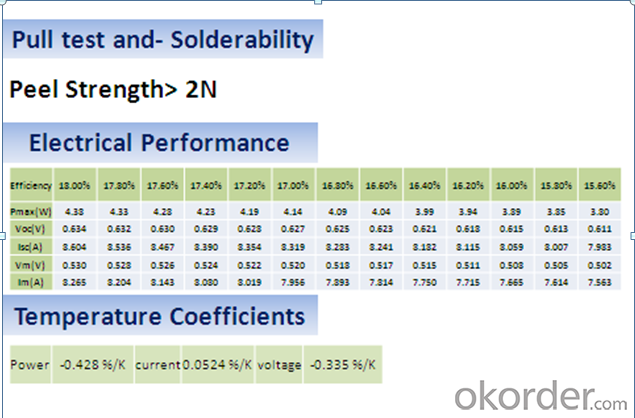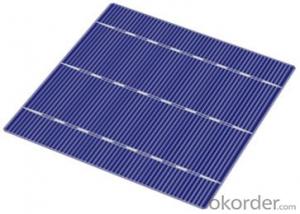solar cells 3BB chain
- Loading Port:
- China Main Port
- Payment Terms:
- TT OR LC
- Min Order Qty:
- -
- Supply Capability:
- -
OKorder Service Pledge
Quality Product, Order Online Tracking, Timely Delivery
OKorder Financial Service
Credit Rating, Credit Services, Credit Purchasing
You Might Also Like

We supply regular mono 125x125mm and poly 156x156mm solar cells.
Cells made in China mainland and Taiwan are both available.
Cell production capacity yearly reach 1GW.
Our cells pattern include continuous and uncontinuous busbar to meet different cells line.
- Q:How can I understand the working principles of solar cells?
- You have to spend more time than you thought to really understand it.
- Q:How do solar cells perform in areas with frequent hurricanes?
- Solar cells can still perform well in areas with frequent hurricanes, provided they are designed and installed with specific considerations in mind. Reinforced mounting systems, robust construction materials, and proper installation techniques can enhance the durability of solar panels against strong winds and debris. Additionally, grid-connected solar systems with battery storage can provide reliable power during power outages caused by hurricanes, making them a resilient energy solution for such areas.
- Q:Can solar cells be used for off-grid power supply?
- Yes, solar cells can be used for off-grid power supply. Solar cells convert sunlight into electricity, which can be stored in batteries for use when the sun is not shining. This makes solar cells an efficient and sustainable option for generating electricity in remote areas or locations without access to the power grid.
- Q:Can solar cells be used for powering remote research stations?
- Yes, solar cells can be used for powering remote research stations. Solar cells, also known as photovoltaic cells, convert sunlight into electricity, making them an ideal choice for locations where grid connections are impractical or non-existent. By harnessing the power of the sun, solar cells can provide a reliable and sustainable source of energy for remote research stations, ensuring continuous power supply for various scientific activities and equipment.
- Q:How do solar cells handle electrical surges or lightning strikes?
- Solar cells are designed to handle small electrical surges or fluctuations in the electrical current, but they are not specifically designed to protect against lightning strikes. In the event of a lightning strike, the solar cells can sustain damage due to the high voltage and current associated with the strike. However, some solar installations include lightning protection systems or surge arresters that can help mitigate the risk of damage caused by lightning strikes.
- Q:What is the impact of solar cells on reducing electricity bills?
- Solar cells have a significant impact on reducing electricity bills as they harness the power of the sun to generate clean and renewable energy. By producing electricity on-site, solar cells can offset a considerable portion of a household's or business's energy consumption, leading to substantial savings on monthly electricity bills. Moreover, excess energy generated by solar cells can be fed back into the grid, allowing homeowners and businesses to earn credits or even receive payments for the surplus energy they contribute. Overall, solar cells offer a sustainable and cost-effective solution to reduce electricity bills and promote energy independence.
- Q:What is a multi-junction solar cell?
- A multi-junction solar cell is a type of solar cell that is composed of multiple layers of semiconductor materials, each with a different energy bandgap. This allows the cell to efficiently capture a wider range of solar radiation by converting different wavelengths of light into electricity. Hence, multi-junction solar cells can achieve higher conversion efficiencies compared to traditional single-junction solar cells.
- Q:What is the impact of electromagnetic interference on solar cell performance?
- Electromagnetic interference can have a significant impact on solar cell performance. It can disrupt the normal operation of solar cells by introducing unwanted electrical signals that interfere with the proper functioning of the cells. This interference can lead to decreased efficiency and power output of the solar panels, as well as potential damage to the cells themselves. Therefore, it is crucial to minimize electromagnetic interference to ensure optimal performance and longevity of solar cells.
- Q:Can solar cells be used in vehicles?
- Yes, solar cells can be used in vehicles. They can be integrated into the design of cars, buses, boats, and even airplanes to convert sunlight into electricity, providing power for various vehicle functions such as charging batteries, running onboard systems, or even powering the entire vehicle.
- Q:Can solar cells be used in desert areas?
- Yes, solar cells can be used in desert areas. In fact, desert regions are ideal for solar energy production due to their high levels of sunlight and low cloud cover. The arid conditions also help keep solar panels clean and free from debris, maximizing their efficiency.
1. Manufacturer Overview |
|
|---|---|
| Location | |
| Year Established | |
| Annual Output Value | |
| Main Markets | |
| Company Certifications | |
2. Manufacturer Certificates |
|
|---|---|
| a) Certification Name | |
| Range | |
| Reference | |
| Validity Period | |
3. Manufacturer Capability |
|
|---|---|
| a)Trade Capacity | |
| Nearest Port | |
| Export Percentage | |
| No.of Employees in Trade Department | |
| Language Spoken: | |
| b)Factory Information | |
| Factory Size: | |
| No. of Production Lines | |
| Contract Manufacturing | |
| Product Price Range | |
Send your message to us
solar cells 3BB chain
- Loading Port:
- China Main Port
- Payment Terms:
- TT OR LC
- Min Order Qty:
- -
- Supply Capability:
- -
OKorder Service Pledge
Quality Product, Order Online Tracking, Timely Delivery
OKorder Financial Service
Credit Rating, Credit Services, Credit Purchasing
Similar products
New products
Hot products
Hot Searches
Related keywords


























